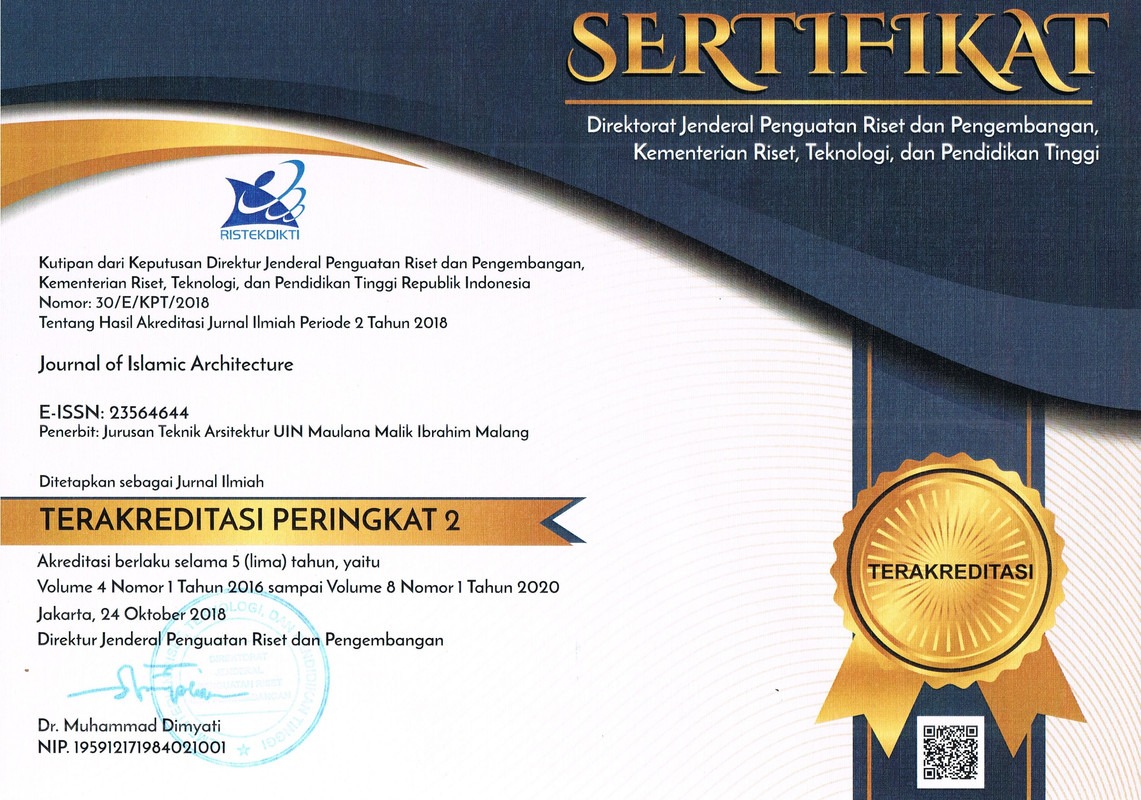THE SIGNIFICANCE OF BUILDING PURSUITS IN ISLAM
Abstract
Abstract
This paper explains the significance of erecting buildings in Islam. Four themes are discussed in the paper: 1) building as a basis of civilization, 2) building as an indispensable and creditable activity, 3) the Prophet Muhammad (pbuh) and building, and 4) avoiding vices in building. The paper concludes that in Islam erecting buildings is a very important enterprise, in that such signifies the creation of a physical locus of the daily individual, family and social activities of Muslims. Thus, the existence of Islamic built environment is essential for the realization of the divine purpose on earth. The chief duty that Islamic built environment performs is the facilitation of such a realization. While writing the paper, I have tried as much as possible to draw on the original sources that deal with the theme at hand, the most important of which, certainly, are the Holy Qur’an and the authentic compilations of Prophet Muhammad’s words and actions. Finally, the paper aims to enhance the awareness, both of the professionals and general readership, as to the importance of correctly conceptualizing, creating and using Islamic built environment. The approach in the paper is conceptual, rather than empirical.
Keywords: Erecting Buildings, Built Environment, Islam, Muslims, Prophet Muhammad (pbuh)
Abstrak
Makalah ini menjelaskan pentingnya pendirian bangunan dalam Islam. Empat tema yang dibahas dalam makalah ini : 1) bangunan sebagai dasar peradaban, 2) bangunan sebagai suatu kegiatan yang sangat diperlukan, 3) Nabi Muhammad (saw) dan bangunan, dan 4) menghindari kejahatan dalam bangunan. Makalah ini menyimpulkan bahwa dalam Islam mendirikan bangunan adalah sebuah usaha yang sangat penting, seperti menandakan penciptaan lokus fisik kegiatan individu sehari-hari, keluarga dan sosial umat Islam. Dengan demikian, keberadaan lingkungan yang dibangun Islam sangat penting untuk mewujudkan tujuan Ilahi di bumi. Pemimpin bertugas memfasilitasi realisasi lingkungan binaan Islam tersebut. Pada penulisan makalah ini, penulis telah berusaha semaksimal mungkin untuk menarik pada sumber-sumber asli yang berhubungan dengan tema, yang paling penting adalah Alquran dan kompilasi otentik kata-kata dan tindakan Nabi Muhammad (Hadits). Akhirnya, makalah ini bertujuan untuk meningkatkan kesadaran, baik dari para profesional dan pembaca umum, mengenai pentingnya konseptualisasi, menciptakan dan menggunakan lingkungan yang dibangun Islam. Pendekatan dalam makalah ini adalah konseptual, bukan empiris.
Kata kunci: Pendirian Bangunan, Lingkungan binaan, Islam, Muslim, Nabi Muhammad saw
Keywords
Full Text:
PDFReferences
Ibn Khaldun (1987) The Muqaddimah. Vol. 2. Translated from the Arabic by Franz Rosenthal. London: Rotledge and Kegan Paul. 2. Le Corbusier (1989) Towards a New Architecture. Translated from the thirteenth French edition with an introduction by Frederick Etchelles. Oxford: Reed Educational and Professional Publishing Ltd. 3. Al-Azraqi (1980) Akhbar Makkah. Vol. 1. n.np. n.pp. 4. The Holy Qur‟an 5. Al-Bukhari. Sahih
Nasr, Seyyed Hossein. Civilizational Dialogue and the Islamic World http://www.islamonline.net/english/Contempor ary.
Parker, Michael and Richards, Colin (1994) Ordering the World: Perceptions of Architecture, Space and Time. In Architecture & Order. Edited by Parker Michael & Richards Colin. London: Routledge.
| Journal of Islamic Architecture Volume 2 Issue 3
June 2013
Fine Arts in Islamic Civilization (1981) Edited by M.A.J. Beg. Kuala Lumpur: The University of Malaya Press
Burckhardt. Titus. (1976) Art of Islam. London: World of Islam Festival Publishing Company Ltd.
Abul Quasim, Muhammad (1975) The Ethics of al-Ghazali. Kuala Lumpur: Central Printing Sendirian Berhad.
Al-Tirmidhi. Sunan
Ibn Majah. Sunan
Al-Samhudi (1997) Wafa‟ al-Wafa. Vol. 1. Beirut: Dar Ihya‟ al-Turath al-„Arabi
Ahmad b. Hanbal. Musnad.
„Uthman, Muhammad „Abd al-Sattar (1988) al- Madinah al-Islamiyyah. Kuwait: „Alam al- Ma‟rifah.
Badr, „Abd al-Basit (1993) al-Tarikh al-Shamil li al-Madinah al-Munawwarah. Vol. 1. Madinah: n.pp.
Al-Tabari, Ibn Jarir (1977) Tarikh al-Rusul wa al- Muluk. Vol. 4. Cairo: Dar al-Ma‟arif.
Abu Dawud. Sunan
Ibn Kathir (1985) al-Bidayah wa al-Nihayah. Vol. 5. Beirut: Dar al-Kutub al-„Ilmiyyah
Abd al-Hamid (1997) Exploring the Islamic Environmental Ethics. Ins. A. R. Aqwan (edit.). Islam and the Environmen, 39-69. New Delhi: Institute of Objective Study.
Al-Faruqi, Isma‟il Raji (1995) Al-Tawhid: its Implications for Thought and Life. Herndon: International Institute of Islamic Thought
DOI: https://doi.org/10.18860/jia.v2i3.2464
Refbacks
- There are currently no refbacks.






